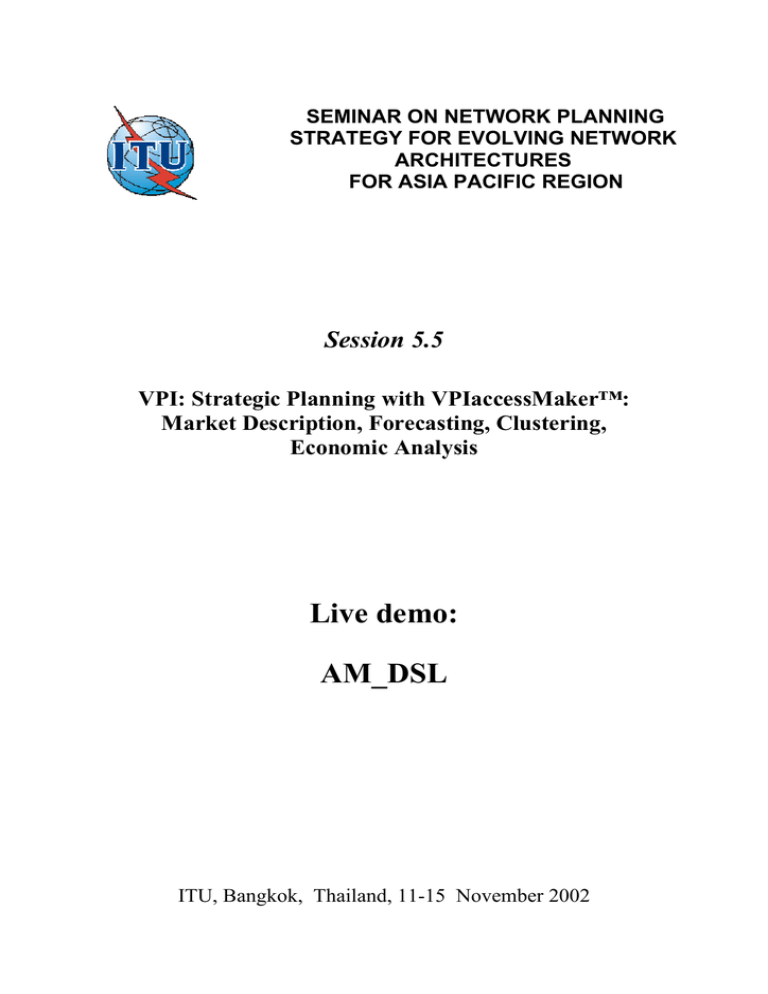Session 5.5
advertisement

SEMINAR ON NETWORK PLANNING STRATEGY FOR EVOLVING NETWORK ARCHITECTURES FOR ASIA PACIFIC REGION Session 5.5 VPI: Strategic Planning with VPIaccessMaker™: Market Description, Forecasting, Clustering, Economic Analysis Live demo: AM_DSL ITU, Bangkok, Thailand, 11-15 November 2002 VPIsystems - DSL Business Case Application Example Digital Subscribers Access Application Project: Dsl 1. Project Goals This case study deals with the various complex issues associated with access network planning, such as market definition and capture, technology selection and modeling, network planning and economic analysis. An extensive techno-economic model has been developed for analyzing the introduction of DSL services (ADSL, SDSL and VDSL) by an incumbent operator in a typical town for serving residential as well as business customers. 2. Market Modeling The study period is 2001 – 2005. Services The services offered are defined as ADSL Basic , ADSL Gold, VDSL and SDSL-Medium Enterprises and SDSL-Small Enterprises. Table 1 - Service Classes Service class Maximum effective bandwidth when all customers are ON ADSL Basic 256 kbps ADSL Gold 0.5 Mbps SDSL – Small Enterprises 0.5 Mbps SDSL – Medium Enterprises 1 Mbps VDSL 5 Mbps Pg .1/10 VPIsystems - DSL Business Case Application Example Customer Classes Five customer groups are modeled in the project. The settings for each customer class are listed below (Table 2). Table 2 - Customer Classes Customer class Subscription charge per month Lines Residential ADSL Basic 30 Euro, decreasing to 20 Euro in 2005 1, constant Residential ADSL Gold 40 Euro, decreasing to 27 Euro in 2005 1, constant Small Enterprises (SDSL) 70 Euro, decreasing to 47 Euro in 2005 1, constant Medium Enterprises (SDSL) 70 Euro per line, decreasing to 47 Euro in 2005 Increasing from 1 to 3.5 in 2005 Residential VDSL 50 Euro, decreasing to 32 Euro in 2005 1, constant The respective price and evolution of lines are stored in the Define Evolution workflow step. Area Description The geographic area is relatively large (aprox. 35 kms by 15 kms) and consists of a set of sub-areas similar to exchange areas (Table 3). There is a city centre surrounded by urban areas with high customer density, while the areas in the edge are suburban areas. Each area is described with a specified mix between residential and business customers. The customer densities per square kilometer in the different areas are shown in Figure 1. Table 3. Number of customers per square km in city centre, urban and suburban areas Customers/Area type City Centre Urban Suburban Residential 2000 2000 1000 Small enterprises 1500 700 100 Medium enterprises 150 70 20 Pg .2/10 VPIsystems - DSL Business Case Application Example Figure 1 - Geographical areas used in the case study. City Centre (Area1-dark green), Urban Areas (light green) and Sub-Urban Areas (white). Market penetration forecasts In each area, specific forecasts are made for services and user groups. The forecasts describe the potential penetration and the market share to the incumbent operator for the different services taking into account the competition from other broadband players. Two sets of residential forecasts are made for ADSL Basic, VDSL Gold, ADSL and LMDS. In the first set (denoted in the densities as “no HFC”), it is assumed that there is no competition from a cable operator. Those are the densities used in the project. As a reference, we have also developed a second set of forecasts assuming competition from a cable operator using HFC; those forecasts are noted in the densities as “HFC”. Figure 2 shows, as an example, the forecasts for Urban areas. The penetration forecasts for the city center are in both cases 10% higher, while the forecasts for suburban area are 10% lower than in urban areas. Pg .3/10 VPIsystems - DSL Business Case Application Example Broadband access penetration forecasts. No cable operator competition. 30,0 25,0 ADSL Basic 20,0 ADSL Gold 15,0 VDSL 10,0 LMDS 5,0 0,0 2001 2002 2003 2004 2005 2006 2007 2008 2009 2010 Figure 2 - Broadband penetration forecasts in Urban areas where there is no competition from a cable operator. Broadband business penetration forecasts are also developed for small enterprises and medium enterprises. We assume that the demand in City center is 10% higher than the demand in Urban areas, while the demand in Suburban areas is 10% lower than in Urban areas. In this case study it is assumed that the incumbent operator has 50%, 60% and 70% of the market demand forecasts for SDSL for small and medium enterprises, respectively in the City Center, Urban areas and Sub-Urban areas. 3. View Market Examples Figure 3 - Revenue distribution in the GIS. Pg .4/10 VPIsystems - DSL Business Case Application Example Figure 4 - Number of subscribers per customer class - Chart. Pg .5/10 VPIsystems - DSL Business Case Application Example Figure 5 - Total bandwidth requirement per customer class – Chart. Pg .6/10 VPIsystems - DSL Business Case Application Example 4. Technology Modeling Table 4 - Technology modeling settings - Technology DSL Parameter DSL Access Mux Add Drop Mux Copper Pair Fiber Link Name of element DS Interface 1 DSLAM ADM-STM16 Copper Pair Fiber Link ADSL (4 Mbps) rounded Up - No acq. cost = 200 Euro inst. cost = 25 Euro maint. cost = 5 EURO STM-4 (622 Mbps) rounded Up - No acq. cost = 5,000 EURO inst. cost = 100 EURO maint. cost = 25 EURO ADSL (4 Mbps) acquisition cost = 0 Euro installation cost = 15 Euro maintenance cost = 15 EURO/km DS Interface 2 SDSL (2 Mbps) rounded Up - No acq. cost = 500 EURO inst. cost = 35 EURO maint. cost = 5 EURO VDSL (24 Mbps) rounded Up - No acq. cost = 750 EURO inst. cost = 30 EURO maint. cost = 5 EURO STM-4 rounded Up - No Not considered 8500 Mbps; 8 - SDSL (2 Mbps) acq. cost = 0 Euro inst. cost = 30 Euro maint. cost = 20 EURO/km STM-4 (622 Mbps) acquisition cost = 5,000 Euro / km installation cost = 15,000 Euro / km maintenance cost = 5% of accumulated investment - - VDSL (24 Mbps) acq. cost = 0 Euro inst. cost = 20 Euro maint. cost = 25 EURO/km - STM-16 (2488 Mbps) rounded Up - No Not considered 2488 Mbps 1 - - Not considered - Not considered - - - 3 kms 15 kms 60,000 EURO fixed plus 5,000 EURO per up-stream interface 10% of acquisition costs 200,000 EURO fixed plus 15,000 EURO per up-stream interface 10% of acquisition costs - - - - 5% of accumulated acquisition 5% of accumulated acquisition - - DSL Equipment; depreciated with the declining balance method, 20% a year. Acquisition costs vary throughout the planning period. ADM Equipment; depreciated with the declining balance method, 20% a year. Acquisition costs vary throughout the planning period. Use initial costs setting Cables; depreciated with the straight line method during 15 years. Cables; depreciated with the straight line method during 15. years. Use initial costs setting Use initial costs setting DS Interface 3 US Interface Infrastructure Capacity Compression factor Maximum Length Detour factor Node/Link Acquisition cost Node/Link Installation cost Node/Link Maintenance cost Component class Existing element expansion Use initial costs setting Pg .7/10 VPIsystems - DSL Business Case Application Example Chains DSLChain: Copper Pair + DSLAM + Fibre Link + ADM-STM-16 DP radius = 0.3 kms 5. Network Design The optimization processes is run with the DSL chain. The network is optimized for the year with the highest demand. No options are set in the Optimization Options dialog. A total of 6 ADMs and 20 DSLAMs are obtained. Pg .8/10 VPIsystems - DSL Business Case Application Example Figure 6 - Network design. 6. View Rollout Example Figure 7 - Cost per network element - Chart. Pg .9/10 VPIsystems - DSL Business Case Application Example Economics Results Figure 8 - Overall economic results – Revenues, Cost, Cash-flow and Net Present Value. Pg .10/10





